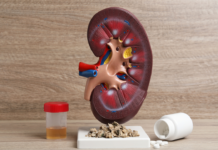Sponsored by: Renadyl
There are thousands of kidney patients that undergo hemodialysis using a hemodialysis catheter or generally referred to as a Central Venous Catheter (CVC). A CVC is a tube-like device inserted into a large vein, usually in the neck or groin. Because two small tubes with caps permanently lie outside the body while the catheter is implanted, it is called an “external vascular access.” The remainder of the catheter (the part you do not see) travels under the skin and into the vein. Ultimately, the internal end of the catheter rests in the top chamber of the heart.
If you have a central venous catheter, this article will help you protect your CVC. To access the bloodstream for dialysis, the two outer tubes are connected to the dialysis machine. But because so much of the catheter resides outside the body, it’s exposed to many more risks, including infection.
Keep your CVC dressing clean and dry at all times:
Watch out for wetness:
Don’t let your CVC become wet. Don’t swim or take a shower. If you take a bath, keep the water shallow, so your catheter stays dry.
Be gentle:
Do not touch/tug/pull on the CVC or the area where the CVC enters your body.
Reports signs of infection:
Call your dialysis facility immediately if you see signs of infection like redness, swelling, or pus. Also, call your doctor or facility immediately if you have any fever or chills. If your facility is closed, then contact your doctor, or go to the nearest emergency room.
Changing your dressing:
What to do if your CVC site becomes dirty or wet?
If your CVC dressing should become dirty or wet while you’re at home, call your dialysis clinic for further instructions on what to do. If your dialysis clinic is closed or instructs you to change your own dressing, use these steps:
- Wash your hands or use hand sanitizer. If you have access to medical gloves, put them on after washing your hands.
- Remove the dirty or wet dressing. Take care not to pull on the catheter.
- Obtain a 3×3 or 4×4 medical gauze and medical tape from your local drugstore or medical supply store.
- Apply new dressing by applying tape to the 4 edges of the gauze.
Learn more about our sponsor Renadyl here https://bit.ly/3sZDWbb
About the author
Steven Belcher, RN, MSN, MS, is a dedicated kidney advocate who began his journey 20 years ago as a dialysis nurse. This job inspired him to help as many people with kidney disease as he could. Not only did he spend two decades caring for a patient’s physical and emotional needs in a clinical setting, but he also educated the public on the risk factors of kidney disease. Some of his many philanthropic successes include being a keynote speaker at the National Association of Nephrology Technicians/ Technologists (NANT), presenting at community spaces, and launching radio shows.
He now focuses his time entirely on his organization Urban Kidney Alliance, which educates the public about kidney disease. His goal? To lower rates of Chronic Kidney Disease in urban communities in Baltimore, Maryland, across the country, and globally through education and collaboration.
Steve has also written the book “HOW TO SURVIVE OUTPATIENT HEMODIALYSIS: A GUIDE FOR PATIENTS WITH KIDNEY FAILURE.” You can read the book review here.
*These statements have not been evaluated by the US Food and Drug Administration. This information is not intended to diagnose, treat, cure, or prevent any disease. Always consult with a qualified healthcare professional prior to beginning any diet or exercise program or taking any dietary supplement. The content on our website is for informational and educational purposes only.




